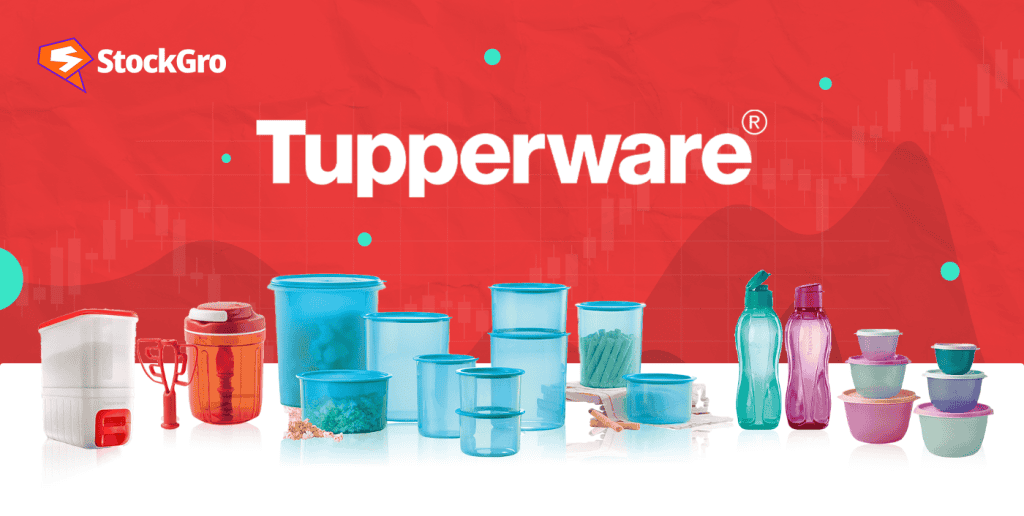
For decades, Tupperware has been a trusted name in households. But on 19 September-2024, it filed for bankruptcy. Sales have dropped, and the competition is fierce. Despite many attempts to change, it couldn’t keep up with shifting consumer habits.
Once a symbol of innovation, the company now faces uncertainty. In this blog, we’ll explore the Tupperware Brand’s bankruptcy and how it reached this point.
The legacy of Tupperware
It might come as a shocker that the household staple ‘Tupperware‘ did not originate in India. The company was founded in the United States back in 1946 & only made its entry into India in 1996. Earl Tupper, a chemist by profession, introduced this airtight, durable container.
At a time when refrigerators were a luxury & food storage solutions were limited, this was a forward-thinking idea. Yet, Tupperware didn’t immediately capture consumer interest. People were unfamiliar with the concept, and traditional retail wasn’t the right platform for such a novel product.
The real turning point came when Brownie Wise, a trailblazing salesperson, redefined how these products were marketed. Her idea of “Tupperware parties” revolutionised direct selling. These in-home demonstrations were more than sales pitches; they became social gatherings.
Wise’s approach not only educated potential customers but also created an environment where selling felt personal and engaging, helping the products find their place in everyday life.
By the 1950-60s, Tupperware’s airtight containers became synonymous with household efficiency. More than just food storage, they represented a cultural shift, especially for women.
Selling these products offered them a chance to earn independently, fostering empowerment long before it became a mainstream discussion. It was not just about storage—it was about self-sufficiency.
Globally, Tupperware spread rapidly. In India, its impact was particularly notable after entering the market in 1996. Beyond practical solutions for Indian households, the company created significant business opportunities for women across the country. Thousands of women found not just a job, but a career path that offered flexibility and independence.
The shift in consumer preferences
Over time, buying habits evolved, and the brand couldn’t pivot quickly enough. Its reliance on plastic—once a breakthrough—became a stumbling block. Eco-conscious individuals increasingly favoured sustainable materials like glass and silicone over conventional options, which no longer aligned with their values.
Meanwhile, the once-popular direct-sales approach lost relevance. With online shopping and home delivery services on the rise, people sought immediate solutions. They no longer required social events to explore products; they expected quick, convenient access.
You may also like: ESG: A new formula for investing success?
Tupperware’s attempted reinvention
When the pandemic hit, Tupperware briefly benefitted from the rise in home cooking and food storage needs. However, the surge was fleeting. By 2022, its revenue dropped 42% from just five years prior.
In a bid to stay relevant, the company shifted its focus to appeal to a more modern audience. By partnering with platforms like Amazon and Target, it aimed to engage digitally savvy shoppers and distance itself from its outdated party-based model.
Yet, these efforts faced significant hurdles. New consumers increasingly sought eco-friendly alternatives, steering away from plastic. The market also became crowded with lower-cost competitors. Coupled with soaring production expenses, the company struggled to maintain a foothold in this new retail landscape.
Tupperware Financial performance
| 2022 | 2021 | 2020 | |
| Sales/Revenue | 1,304 | 1,601 | 1,558 |
| Sales growth | -18.53% | 2.75% | -13.35% |
| Gross income | 834 | 1,066 | 1,049 |
| Gross income growth | -21.73% | 1.55% | -11.83% |
| EBIT | 99 | – | – |
| Net income | -247 | 151 | 111 |
| Net income growth | -263.51% | 36.16% | 794.35% |
Tupperware stock market performance
News of an impending bankruptcy filing sent shockwaves through the market, causing the stock value to plunge by more than 50% this week ( as of 18 September). Investors quickly reacted, leading to a dramatic sell-off as confidence in the brand’s financial stability evaporated.
Over the past year as of September 16-2024, Tupperware’s shares have plunged by 73.44%.

Zooming out to a five-year perspective, the situation worsens considerably—its value has dropped by 96.7%.

Also Read: What is the role of FIIs in the Indian stock market?
Tupperware bankruptcy
On 19 September-2024, Tupperware Brands Corporation took the significant step of filing for Chapter 11 protection in the U.S. Bankruptcy Court for the District of Delaware.
After years of financial instability driven by broader economic challenges, the leadership decided that this path was the most suitable for preserving the brand’s legacy. CEO Laurie Ann Goldman acknowledged that, despite exploring several options, filing for bankruptcy would provide the necessary flexibility to move forward.
The financial filing highlights the extent of the crisis. With assets valued between $500 million & $1 billion, the company faces liabilities that fall between $1 billion – $10 billion. A key issue has been its struggle to manage $700 million in loans, despite efforts to renegotiate terms. The debt burden continued to grow, pushing the business to this critical juncture.
Tupperware’s path forward
Tupperware finds itself at a crucial turning point, going through the complexities of Chapter 11 bankruptcy. Despite the financial strain, the brand remains focused on keeping its operations steady while paving the way for a resurgence. The newly appointed management, in place for a year, has already started improving efficiency, setting the stage for what lies ahead.
A major priority is securing court approval to continue functioning during these proceedings. The plan is to serve customers through various channels—longstanding sales consultants, retail partners, and the online platform. Keeping products accessible is key to maintaining customer loyalty and engagement.
Central to its revival is a shift toward a digital-first model. By modernising its systems & also embracing the online retail space, the company hopes to stay competitive in a fast-changing market. Additionally, it is exploring potential sales or partnerships to breathe new life into the business.
You may also like: Bankruptcy recovery: How financial literacy can help you start fresh?
Tupperware competitors
The iconic brand now faces rivalry from both local and global players. Low-cost alternatives like Clorox’s GladWare, innovative product options with Newell Brands Inc, other brands like Instant Brands and Reynolds Consumer Products Inc challenge the Tupperware brand’s position. Homegrown labels like Signoraware, Cello, Nayasa are making it harder for Tupperware to retain its foothold.
Additionally, the rise of reusable restaurant takeout containers during the pandemic has lessened the need for traditional storage solutions, amplifying the brand’s difficulties.
| CY 22/ $ millions | Tupperware Brands | Clorox | Newell Brands |
| Sales/Revenue | 1,304 | 7,107 | 9,459 |
| Gross income | 834 | 2,491 | 2,807 |
| Net income | -247 | 462 | 197 |
Source: Wall Street Journal (as of September 19)
Bottomline
Tupperware bankruptcy is a turning point in its history. As the business restructures, it leans heavily on digital transformation and modern retail strategies. With significant challenges ahead, including shifting consumer trends and rising competitors, the next steps will be crucial. Whether Tupperware can adapt and evolve will ultimately define its survival and relevance in today’s changing landscape.

